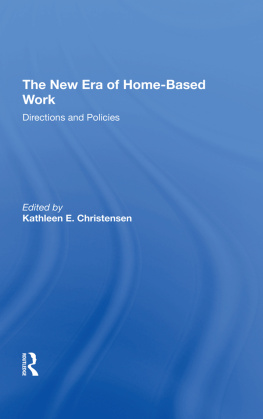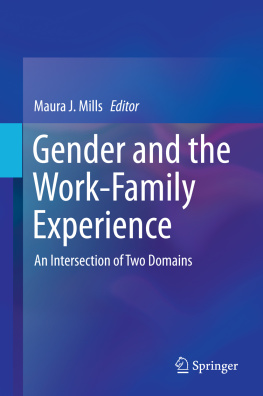First published 1988 by Westview Press
Published 2019 by Routledge
52 Vanderbilt Avenue, New York, NY 10017
2 Park Square, Milton Park, Abingdon, Oxon OX14 4RN
Routledge is an imprint of the Taylor & Francis Group, an informa business
Copyright 1988 Taylor & Francis
All rights reserved. No part of this book may be reprinted or reproduced or utilised in any form or by any electronic, mechanical, or other means, now known or hereafter invented, including photocopying and recording, or in any information storage or retrieval system, without permission in writing from the publishers.
Notice:
Product or corporate names may be trademarks or registered trademarks, and are used only for identification and explanation without intent to infringe.
Library of Congress Cataloging-in-Publication Data
The New era of home-based work.
Includes index.
1. Home-based businesses. 2. Telecommuting.
I. Christensen, K. (Kathleen)
HD2333.N48 1988 331.25 88-14148
ISBN 13: 978-0-367-29435-9 (hbk)
This important book conveys some of the profound changes occurring in the assumptions, meanings, and practice of workplace and workforce. The simple view of the Industrial Revolution is that work shifted from farm and home to mill. Yet that view profoundly neglects the continuing importance of womens household labor in making men and women available for work outside the homewhat has come to be called the reproduction of labor; in addition, the separation of work and home has never been complete. Homework defined as paid industrial labor performed at home has persisted in the United States despite legislative attempts to limit it. Many office workers and professionals are expected to continue their salaried duties after employer-based working hours: Witness the briefcase brigade of commuters and others.
This book analyzes a significant emerging chapter in the continuous and sometimes tumultuous renegotiations involving employers, employees, technology, workplace, and workhours. The work relationship is not a fixed set of formulas, agreements, procedures, or rules. For example, the Wagner Act of the 1930s moved labor relations toward greater participation of unions in bargaining for employees. Today, the theme of improving U.S. participation and competitiveness in global markets has weakened workers and unions influence in workplace relations. Employers are asking their unionized factory workers to be more flexible about job titles, pay schedules, seniority, and work task regulations (sometimes providing incentives such as year-end bonuses tied to profits).
Home-based white-collar work can be seen as part of the expansion of contingent work: part-time, temporary, or off-the-premises employment. An alternative interpretation might be that it is the human resource equivalent of the Japanese practice of just-in-time inventory process, since it avoids the stockpiling of staff. Many expect that both contingent work and its home-based white-collar component will grow rapidly as they fit into the business desire for employer flexibility and lower wage and fringe benefits costs. If they do grow as expected, safeguards may be necessary to regulate these work patterns, for the many who work in these ways are particularly vulnerable to exploitation.
Todays home-based white-collar work is not an add-on to the working day as is the briefcase brigade, but rather, it is the major form of paid work for a growing number of women and for a smaller number of men. As the authors in The New Era of Home-Based Work dispassionately point out, home-based workers sometimes pay a price for the flexibility of place and time that such work offers.
Although white-collar home-based work can be viewed as continuing past traditions of home-as-workplace, it should also be seen as moving onto new tracks made possible by the high technology of computer processing. For example, U.S. employers insistence on physical and social control of the work process, thus requiring a large supervisory force, is overcome in home-based work. Performance or output measures, eased by the computers capacity for data processing, are deemed sufficient. White-collar home-based work assumes that employees will provide the physical infrastructure usually supplied and controlled by employers. The split between formal and informal work sectors has never been sharp; home-based work may foretell a formal informal sector in which on-the-books, regular employers operate through the premises of those who are presumably employees.
Home-based white-collar work should be seen as transactional, for both employees and employers are involved in structuring this arrangement. The former may desire the arrangement as much as many employers who seek reduced labor and space costs. Home-based work should be viewed in broader terms than an economic arrangement.
Among its negative components is that home-based work impinges more obviously and perhaps directly on family relations and child development than do centralized work settings. A mother working at home may be more physically present than if she worked in a faraway office, but she may also be preoccupied with her work demands because she has no fixed, limited work schedule. The home may not be a haven for any of its members.
The new arrangements raise questions of the legal and economic relationship of employers and those who are paid by them. This issue is evident in the debate about who is an independent contractor and to what extent that designation is a dodge to reduce burdens on and responsibilities of employers.
Michael Piore informs us that the profound separation in manufacturing between home and work led to the invention of the concept of unemployment.The contributors diversity of vantage points (academic, government, unions) aids us in interpreting the swiftly moving phenomenon of home-based white-collar work. Their chapters help us consider what is changeable and inexorable in the future of home-based white-collar work and which options and choices to pursue or set aside. Areas of ignorance are pointed out rather than covered by rhetoric.
As workplace and workforce change, our received wisdoms about desirable directions need reappraisal. Research that is both historical and contemporary aids our understanding of the continuous process of renegotiation in the relationships of market and society. The New Era of Home-Based Work initiates a new stage in the study of one important component of the significant changes that are occurring and that will likely speed up. It is an excellent beginning.
S. M. Miller
Boston University
Notes












